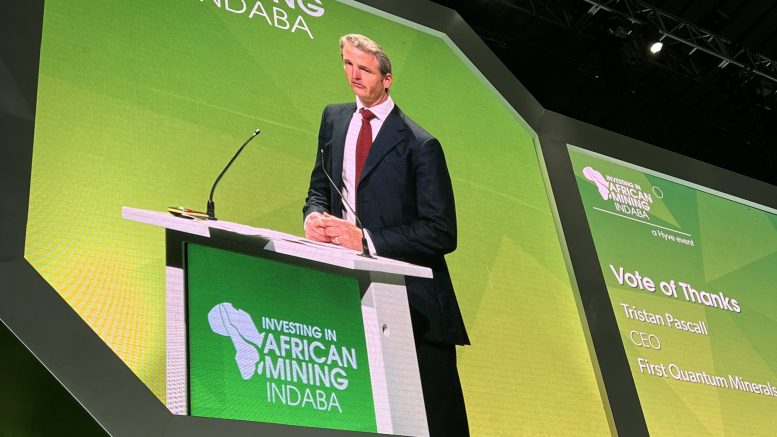The board of First Quantum Minerals (TSX: FM) has resolved to proceed with a US$1.3 billion expansion of the company’s cornerstone Kansanshi copper mine in Zambia, including the Enterprise nickel project.
Called the S3 Expansion, the project is expected to transition the mine from its current selective high-grade, medium-scale operation to a medium-grade, larger-scale mine able to deal with a higher proportion of sulphide mineralization at depth.
According to a September 2020 technical report, the S3 Expansion entails the construction of a standalone 25-million-tonne-per-year processing plant with a new, more extensive mining fleet that will push throughput to 53 million tonnes per year. Once the expansion is completed, copper output from Kansanshi is expected to average about 250,000 tonnes annually for the remaining mine life to 2044.
The company reports a significant portion of the civil and structural work onsite for the S3 Expansion has been completed. The remaining work includes completing the remaining engineering design works, procurement and installation of equipment, electrics, controls and infrastructure.
The S3 processing train will comprise a 28-megawatt SAG mill and a 22-megawatt ball mill. The open-pit mine will be expanded to increase the supply of sulphide ore from the Main Pit and extend into the South East Dome deposit. The expanded mining fleet will use similar ultra-class equipment as First Quantum’s other vital mines. It will benefit from new electrical loading and drilling equipment, and the extension of the current electric trolley assist infrastructure.
In parallel with the expansion of the mine and processing facilities, First Quantum plans to increase the throughput capacity of the Kansanshi smelter from 1.4 to 1.7 million tonnes per year of concentrate. This will enable the smelter to produce over 400,000 tonnes per year of copper anode.
The total capital expenditure associated with the S3 Expansion totals US$1.3 billion, which includes US$900 million on the S3 plant and mine fleet and US$350 million for pre-stripping of the South East Dome pit. About US$800 million of this spending is included in the company’s current three-year guidance released on Jan. 17, with the balance falling beyond the guidance period.
The first production from the S3 Expansion is expected in 2025.
Enterprise nickel
First Quantum will also move ahead with the US$100-million Enterprise nickel project 12 km northwest of the Sentinel copper mine.
As per a March 2020 technical report, the operation is underpinned by proven and probable reserves at Enterprise total 34.7 million tonnes of ore at 0.99% nickel
The project comprises a single main open pit and one extension to the southwest.
The existing 4-million-tonne-per-year nickel circuit was previously built as part of the original Sentinel processing complex. First Quantum says that the main work stream to bring the project online will be the pre-strip of waste.
The low-cost, high-grade Enterprise nickel project is well placed to supply the rapidly growing electric vehicle battery sector.
The development of the Enterprise operation is expected to total about 12 months. Enterprise is to produce an average of 30,000 tonnes per year of nickel in high-grade concentrate at full tilt.
Pre-striping of the deposit is expected to cost US$60 million, with US$40 million relating to infrastructure construction and plant commissioning.
First nickel is expected by 2023, totalling 5,000 to 10,000 tonnes.
‘New Dawn’ administration
First Quantum CEO Tristan Pascall told the African Mining Indaba in Cape Town on Monday the investment decision reflected the company’s increased confidence in the investment climate in Zambia.
“First Quantum has been working constructively with the government of Zambia’s ‘New Dawn’ administration as part of their efforts to reform the mining sector, attract investment and increase Zambia’s copper production,” he told the conference of about 6,000 attendees from 30 countries.
“The S3 Expansion and the Enterprise nickel project are a key part of our brownfield growth strategy,” he said.
The Kansanshi mine has been a cornerstone asset for First Quantum for 15 years.
The approval of these two projects is an essential milestone for the company’s path towards responsible production growth of the metals needed for the global green energy transition.

A worker in the smelter at First Quantum Minerals’ majority-owned Kansanshi copper mine in Zambia. Credit: First Quantum Minerals.
The Indaba heard from Zambia’s president, Hakainde Hichilema, who underscored his government’s commitments to address the ease of doing business in Zambia. Since coming to power eight months ago, the administration has worked to roll back the damage the previous administration had wrought to foreign investment in Zambia.
“We are committed to building a resilient, sustainable mining industry anchored on environmental, social, and governance standards of best practice. We do this because this is a bare minimum. If we do it correctly, our determination to foster industrialization, and obviously, job creation and other business opportunities are very clear,” said Hichilema.
These commitments cover areas such as expediting immigration procedures in exchange for obligations for local employment levels, competitive pricing of power transmission and power procurement from independent sources, which will support renewable energy projects, and measures to ensure the ease of importing and exporting goods.
First Quantum’s approvals follow the re-introduction of the deductibility of mineral royalties for corporate income tax assessment purposes that became effective in January. This measure is seen as realigning Zambia with international best practices.
Pascall said the government’s commitment to improving the predictability of the mining fiscal regime also provided the certainty needed to support significant capital investments in Zambia.
Pascall noted that First Quantum and the Zambia government were able to resolve all points of contention that had been stumbling blocks to progress on the S3 Expansion and Enterprise nickel project. “This includes reaching agreement with respect to the outstanding value-added tax receivable sum and an approach for repayment based on offsets against future mining taxes and royalties,” said Pascall.



Be the first to comment on "Mining Indaba: First Quantum pulls trigger on US$1.3B Kansanshi expansion"